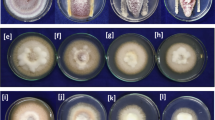Summary
Eight ineffective mutant strains were isolated from N-methyl-N'-nitro-N-nitrosoguanidine mutagenized cultures of cowpea Rhizobium strain 32H1. Strains CR1, CR2, CR3, CR4, CR5 and CR6 induced more, but smaller, nodules than the wild type. With the exception of strain CR2, these mutant strains reduced less than 1% of the amount of acetylene reduced by the wild type, in both the free-living and symbiotic assays. Strain CR2 reduced acetylene in the free-living assay but not in the symbiotic assay. Strains CR7 and CR8 responded variably (5–20% of the wild type) in free-living and symbiotic acetylene reduction assays. Nodules also varied from small white to normal-sized pink nodules. The phenotypic characteristics of the mutant strains were consistant with all leguminous plants tested and were stable upon reisolation from nodules. Fully effective revertants were selected from 4 of the ineffective mutant strains by the use of the leguminous plant,Macroptilium lathyroides. Serology, patterns of resistance to anti-bacterial agents, phage-typing, and antibiotic resistance markers were used to confirm strain identification.
Similar content being viewed by others
References
Adams M H 1959 Bacteriophages. Wiley Interscience, New York, 592 p.
Ahmed S and Evans H J 1960 A micronutrient element for the growth of soybean plants under symbiotic conditions. Soil Sci. 90, 205–210.
Beringer J E, Johnston A W B and Wells B 1977 The isolation of conditional ineffective mutants ofRhizobium leguminosarum. J. Gen. Microbiol. 98, 339–343.
Bishop P E, Guevara, J G, Engelke J A and Evans H J 1976 Relation between glutamine synthetase and nitrogenase activities in the symbiotic association betweenRhizobium japonicum andGlycine max. Plant Physiol. 57, 542–546.
Josey D P, Beynon J L, Johnston A W B and Beringer J E 1979 Strain identification inRhizobium using intrinsic antibiotic resistance. J. Appl. Bacteriol. 46 343–350.
Keleti J and Lederer W H 1973 Handbook of Micromethods for the Biological Sciences. Van Nostrand Reinhold. New York. 166 p.
Maier R J 1977 Ph.D. Thesis Department of Bacteriology, University of Wisconsin-Madison. 160 p.
Maier R J and Brill W J 1976 Ineffective and non-nodulating mutant strains ofRhizobium japonicum. J. Bacteriol. 127, 763–769.
Maier R J and Brill W J 1978 Involvement ofRhizobium japonicum O-antigen in soybean nodulation. J. Bacteriol. 133, 1295–1299.
Pain A N 1979 Symbiotic properties of antibiotic-resistant and auxotrophic mutants ofRhizobium leguninosarum. J. Appl. Bacteriol. 47, 53–64.
Pankhurst C E 1977 Symbiotic effectiveness of antibiotic-resistant mutants of fast-growing and slow-growing strains ofRhizobium nodulatingLotus species. Can. J. Microbiol. 23, 1026–1033.
Pinto C M, Yao P J and Vincent J M 1974 Nodulation competitiveness amongst strains ofRhizobium meliloti andR. trifolii. Aust. J. Agric. Res. 25, 317–329.
Rice W A and Olsen P E 1980 Four effective strains tolerant to acid conditions out competed indigenous effective nodules.In Current Perspectives in Nitrogen Fixation. Eds. A H Gibson and W E Newton Elsevier/North-Holland, New York, pp 440–441.
Robinson A C 1969 Host selection for effectiveRhizobium trifolii by red clover and subterranean clover in the field. Aust. J. Agric. Res. 20, 1053–1060.
Singh R B, Dhar B and Singh B D 1980 Morphology and general characteristics of virus active against cowpea Rhizobium CB756 and 32H1. Arch. Virol. 64, 17–24.
Vincent J M and Waters L M 1953 The influence of the host on competition amongst clover root nodule bacteria. J. Gen. Microbiol. 9, 357–370.
Wacek T J and Brill W J 1976 Simple, rapid assay for the screening of nitrogen-fixing ability in soybean. Crop Sci. 16, 519–522.
Williams P M 1981 The isolation of effective and ineffectiver mutants of cowpea Rhizobium. Plant and Soil 60, 349–356.
Author information
Authors and Affiliations
Additional information
Cooperative investigations of the United States Department of Agriculture, Agricultural Research Service and the North Carolina Agricultural Research Service, Raleigh, North Carolina. Paper no. 8834 of the Journal Series of the North Carolina Agricultural Research Service at Raleigh.
Rights and permissions
About this article
Cite this article
Misplon, J.A., Bishop, P.E. Isolation and partial characterization of Fix− mutants from Rhizobium strain 32H1. Plant Soil 74, 395–406 (1983). https://doi.org/10.1007/BF02181357
Received:
Revised:
Issue Date:
DOI: https://doi.org/10.1007/BF02181357




